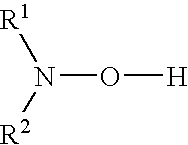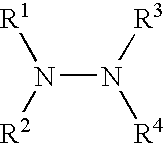Liquid additive for intergrinding cement
- Summary
- Abstract
- Description
- Claims
- Application Information
AI Technical Summary
Benefits of technology
Problems solved by technology
Method used
Image
Examples
example i
[0051] Tin sulfate and tin chloride, in both solid and liquid (e.g., aqueous solution) forms, were tested by intergrinding with them with Portland cement in a laboratory ball mill, and then pore water is obtained from the cement sample thus made to ascertain chromium levels.
[0052] The proportions of materials in the laboratory prepared cement are as follows: 95.3% clinker, 2.8% gypsum, and 1.9% plaster. The grinds were prepared at ambient temperature. The tin sulfate and tin chloride were added in the various dosages shown in Table I below. The dosage for the active stannous tin portion is also given in Table I.
[0053] Soluble ppm chromium (measured as chromate) is given for the cold grind as prepared, as well a portion of the grind that was heat treated at 180° C. for 2 hrs. The purpose of heat treating the grind is to determine the relative resistance of the chromium (“Cr”) reducing agent to ambient oxidation, and, hence, its effectiveness after cement storage.
TABLE IColdHeatGr...
example ii
[0060] For comparison, a similar test was done on a different cement interblended (post-grinding) with iron II sulfate. Dosages of 1000-3000 ppm of FeSO4*7H2O lose effectiveness after heating. A dosage of 5000 ppm is required for sustained effectiveness. Dosages of 3000-5000 ppm are typically used to maintain effectiveness after storage. Data is shown in Table II.
TABLE IIUK Type I OPCAdded Iron IINo heating180° C. for 2 hrsSulfate heptahydrateMeasuredmeasuredppmCr (VI) ppmCr (VI) ppm 09.810.2 10000.59.630000.03.450000 1.0
example iii
Co-Additives
[0061] Efficiency of stannous tin for chromium reduction can be further enhanced by addition of a co-additive to the tin chloride solution. Examples of such co-additives are other reducing agents, such as L-ascorbic acid, which is ineffective in the reduction of chromium in cementitious systems by itself.
[0062] Table III shows a performance comparison of a first solution comprising tin chloride (62%) and water (38%), and a second solution comprising tin chloride (58%), ascorbate (6.1%), and water (35.9%).
[0063] [Table Begins on Next Page]
TABLE IIIColdHeatGrindTreatedAdditiveSn 2+ppmPpmChromate reducing Additive(Ppm)(ppm)CrCrNone——89Stannous chloride powder 422657Stannous chloride powder171107 62% stannous chloride solution 69225862% stannous chloride solution28593562% stannous chloride solution571186 Tin chloride / Ascorbic acid solution 852657Tin chloride / Ascorbic acid solution1715225Tin chloride / Ascorbic acid solution28587
[0064] Both additives were interground into a ...
PUM
| Property | Measurement | Unit |
|---|---|---|
| Fraction | aaaaa | aaaaa |
| Fraction | aaaaa | aaaaa |
| Fraction | aaaaa | aaaaa |
Abstract
Description
Claims
Application Information
 Login to View More
Login to View More - R&D
- Intellectual Property
- Life Sciences
- Materials
- Tech Scout
- Unparalleled Data Quality
- Higher Quality Content
- 60% Fewer Hallucinations
Browse by: Latest US Patents, China's latest patents, Technical Efficacy Thesaurus, Application Domain, Technology Topic, Popular Technical Reports.
© 2025 PatSnap. All rights reserved.Legal|Privacy policy|Modern Slavery Act Transparency Statement|Sitemap|About US| Contact US: help@patsnap.com


